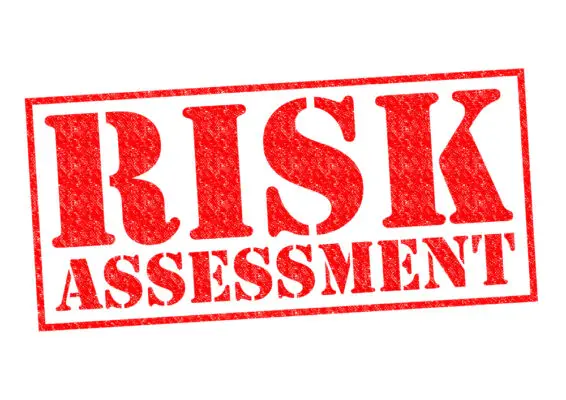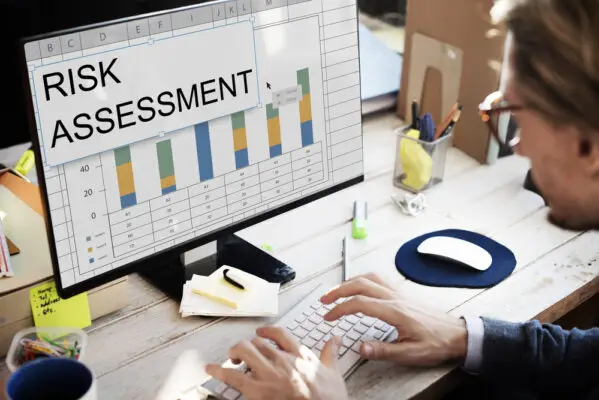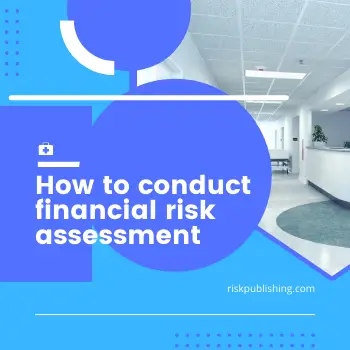The world can be unpredictable at times, especially during the current pandemic. Organizations need to prepare for the future. What would an organization do if disasters disrupt operations and curtail business profit? Inform of operational risk, which ultimately is business risk.
If an organization does not have an alternative plan for financial investments, the organization will cease existence. That’s why it is critical to identify a financial risk that prevails in making business decisions.
Risk management is an activity that incorporates risks related to business decisions following sound risk management practices of risk factors and business risks.
However, the more proactive approach is developing international financial investments or building up an investment portfolio that can provide financial stability during disruptions.
Any good financial risk assessment will reveal where your funds are invested; without knowing this information, it’ll be difficult for organizations to know what steps to consider to ensure long-term profitability. This article will explore how conducting a financial risk assessment can help an organization for long-term sustainability and profitability.
The assessment process brings a better understanding of the daily operations of a primary goal of a business to make profits. Decision-making is a risk management goal that provides the right jobs to prevent serious damage to business customers.
Adherence to government regulations for companies to protect client outcomes and create relationships for firms to conduct the course of actions to conduct financial risk analysis and identify the financial risk of the risk occurring and potential risk in various scenarios looking at the company outcome.

What are financial risks?
Financial risks are the possibility of losing or not gaining value. In financial markets, uncertainty is generally associated with changes in price over time. Financial risk can be measured as volatility using statistical measures such as standard deviation and variance.
In the modern financial landscape, crafting a robust investment strategy requires a comprehensive understanding of various risk factors and their potential impacts on a company’s financial health. Operational, physical, regulatory, and reputational risks are some of the central risk categories that require diligent monitoring.
Financial institutions must be cognizant of the market conditions, utilizing an analytical tool that blends qualitative and quantitative risk analysis. This enables the Finance team to calculate the cost of capital, understand human capital needs, and predict financial instability.
Leveraging business intelligence tools and having proper controls, such as Banking and Financial controls, ensures the alignment of the financial risk assessment process with the company’s risk profile.
Model of risk and risk models should be carefully developed to accommodate the company structure, such as asset allocation strategies by asset managers and maintaining sufficient cash flow to adapt to amplified impacts such as climate events and financial crises, like the 2007-08 financial crisis.
The financial risk management process is not isolated but closely tied to broader economic risks and environmental factors such as the Risks of climate change. Strategies must consider the financial impact, physical impacts, and the transition towards a carbon-neutral economy.
Proper assessment includes engaging with third-party vendors and alternative vendors and understanding financial obligations, including sanctions obligations.
The management team must collaborate with business leaders to mitigate risks from business model failure, assess banking lending conditions, and ensure Debt & Equity balance. This effort should cover tax revenues, the income statement, and balance sheet accounts and include strategic planning process and succession planning.
Furthermore, factors such as banking relationships, sovereign debt sustainability, adaptation efforts, and department-level budgeting need integration within the framework. The level of protection against illicit and private sector actors must be gauged, enabling organizations to take advantage of inefficiency, income, and opportunities.
Ultimately, the financial risk process, involving riskier investments, recovery investments, and risk analytics, should be cohesive and aligned with productive investments, utilizing financial ratios like the Current Ratio and assessing rate of return and future returns.
This systematic approach offers a better-informed risk financing strategy, aligns with the basic business operations, and equips the enterprise to respond to the ever-changing financial landscape with agility and foresight.
Another measure of financial risk is beta which measures a security’s non-diversifiable risk relative to the sector as a whole. Financial risk is associated with the volatility of future cash flows and returns from an activity or investment.
Sources of uncertainty in the marketplace
In practice, three broad types of uncertainties can apply to any financial instrument:
1) Fundamental uncertainties: These include economic, political, and environmental factors that drive the need for any financial asset. For example, to buy insurance, an individual must first believe they are at risk of suffering loss.
2) Systematic risks include sector-wide uncertainties such as interest rates or inflation changes. For example, if interest rates fall by 1% tomorrow, all fixed-income securities (such as bonds) will fall in value.
3) Firm-specific risks: These are specific to the issuer of the financial asset and can include political or legal changes in the management of technological change.
For example, individual CFOs may come and go, but CFOs at other firms will not usually affect the value of an organization’s shares.
What are examples of financial risks?
Some examples of financial risk include:
(a) Credit risk (the risk of default) is the risk that a borrower (a seller in a transaction) may fail to repay the total amount of credit extended or fail to pay on time. It arises when a business, individual, or organization encounters financial difficulty in making decisions about debt service payments when due.
(b) Equity risk (the risk of a decline in the value of an asset) is the chance that a security’s price will decline. It can happen when macroeconomic events affect a specific type of security, industry group or small business.
(c) Foreign currency risk (the risk level of loss from changes in exchange rates) is the chance that a foreign currency transaction will decrease in value because of a sharp shift in exchange rates.
For example, if the yen strengthens significantly against the dollar, Japanese exports to America would become more expensive. American goods exported to Japan would become cheaper on the Japanese market.
(d) Interest rate risk (the risk of loss from changes in interest rates) is the chance that a change in interest rates will hurt bond prices, option premiums, or other financial instruments with cash flows affected by interest rates.
For example, if you buy a ten-year government bond today for $1,000, you expect to get back $1,100 in ten years. If interest rates rise by 1%, an organization will only receive $1,050 back in ten years.
(e) Liquidity risk (the risk of loss from lack of marketability) is the chance that an investor cannot sell a financial asset quickly when needed. It can be essential for bonds, which are less liquid than equities.
Liquidity risk is different from market risk because the prices in the market may not move, but it might be challenging to buy or sell at that moment.
(f) Market risk (the risk of loss from adverse changes in the overall market) is the risk investment will lose value due to general market factors, such as changes in prevailing interest rates or inflation. For example, suppose investors begin to fear inflation is likely to increase significantly.
In that case, they may want to buy fewer bonds and demand higher yields on bonds already held, adversely affecting bond prices.
Purpose of risk assessment
Risk Management guidelines ISO 31000:2018 define risk assessment as “the overall process of identifying, analyzing, and assessing risk. It includes the determination of risk criteria, risk estimation, and risk evaluation.” Risk assessment is a key part of managing financial risks.
Risk assessment allows businesses to make informed decisions about their risks. Performing risk assessments help organizations avoid unnecessary losses that can hurt their bottom line and cash flow through monitoring accounts payable. An assessment process of financial risks
1. Risk assessment is especially important for organizations heavily involved with financial services, such as banks and insurance companies. The risks the organizations face are very high, and they must carefully assess them to ensure they do not take on more than they can handle. Risk assessment is crucial for monitoring the risks involved in these types of businesses.
2. Risk assessments must be performed when financial positions change or enter new situations, such as long-term investments. Financial position changes occur through borrowing, spending, investing, and other activities that can change a company’s financial standing.
3. As organizations increase in size and complexity, managing becomes increasingly difficult. Even more critical is to perform risk assessments. It helps organizations determine their overall financial standing and protect themselves from unforeseen risks that could threaten this standing.
4. The objective of risk assessment assists companies in identifying the risks in their procedures and finances to determine if they can handle these risks. Risk assessment helps avoid unexpected losses that could hurt a company’s bottom line.
Risk assessment is performed per the ISO 31000:2018 guidelines set forth by the International Organization for Standardization (ISO) to assess how much uncertainty will be involved when taking on a particular process.
Small businesses need to be cognizant of new and potential risks in line with risk appetite providing considerable benefits to business administration to the business owner.

Financial risk assessment
It is the procedure for discovering, evaluating, and evaluating financial risks to determine their impact. The goal is to treat these risks by transferring them or mitigating them, increasing the value of the business.
The process begins with risk identification, where all potential sources of financial risks are identified through knowledge of what has caused past failures in your industry. Identification will involve categorizing the risks into their categories—i.e., liquidity or credit risk.
Incorporating knowledge of your business and emerging risks from new technologies, global markets, and the economy into the identification process is essential. After identifying potential sources of risk, you can then move into the risk analysis.
During this risk analysis process, future forecasts and scenarios are examined with a critical eye to ascertain whether there would be any adverse consequences. Financial risk analysis may be qualitative or quantitative, and projections are based on past performance and extrapolations.
The next step is to evaluate how these risks might affect your company’s value. Risks that will have the most significant impact will be those you want to try and treat through mitigation or transferring them off your balance sheet. Here quantitative analysis such as NPV (net present value) and other tools are applied to the risk.
After identifying, analyzing, and evaluating your risks, it is essential to mitigate any negative ones or transfer them through hedging if necessary.
The goal of financial risk assessment is not only identification but also mitigation. Mitigation includes employing hedging strategies or risk transfer options. It includes ascertaining the likelihood of development in the industry, taking the growth of firms and clients to create the best procedures to establish a client relationship.
Hedging strategies can include interest rate or foreign exchange derivatives, physical holdings of commodities like gold, silver, oil, and stock futures, selling off highly liquid assets, and selling off excess inventory.
Risk transferring helps manage risks by having an outside party assume the risks you cannot handle. It can be done through product warranties and insurance or selling off the risk to an outside party.
The final step of financial risk assessment is to monitor your risks regularly using the processes of identification, analysis, evaluation, mitigation, and transfer options. It allows you to ensure your current market exposure is as low as possible. It ensures that business operations are not affected by risk occurring.
Financial Risk Assessments – What are they, and why does your company need them?
Numerous firms are unaware they are at risk or what the risks they face are. Studying organizations thoroughly, especially on a fiscal level, is important to avoid financial loss.
Even the best of businesses can falter if not adequately protected against all possibilities of fiscal disaster. A financial risk assessment might assist you in identifying potential dangers in these issues and put plans to mitigate against the risks and derive operational benefits.
Financial risk assessments can provide vital information about a company and give insight into its financial growth before it gets out of control. A good evaluation can identify problems such as cash flow, liquidity, or customers’ credit issues.
Identifying too late that a company is over-leveraged may cost a lot more money in the end. When doing a financial risk assessment, an organization is taking steps to ensure it doesn’t happen. A good assessment should identify the vulnerabilities of a business and provide information on how to make corrections or improvements.
A financial risk assessment can assist in identifying financial risks in a company. The examination may uncover areas that need immediate attention and those that are functioning effectively.
A consistently successful company that is not concerned about potential hazards may still be missing something that can detonate or prevent them from seizing chances. This analysis is used in the planning and budgeting process. However, it may be updated to identify and consolidate deficiencies and ensure that you act on dangers at least once a year.
Key business components to review in a financial risk assessment
A financial risk assessment should look at many different aspects of a business to determine overall risk.
The following components may be included in the assessment:
● Audit and compliance.
● Capital resources, such as working capital and cash flow.
● Debt management and other commitments.
● Legal and regulatory processes.
● Tax planning and compliance.
● Valuation of assets, personnel, and company.
● Valuation of receivables and payables.
● Accounting policies for revenue recognition.
● Allocation of investments/liabilities to different business units or divisions.
● Create financial statements review and address.
● Net worth assessment.
These are the key components of your business reviewed and some questions that need addressing in the review process.
Risk Assessments for Investments
A statistic used to estimate investor unpredictability The standard deviation of an investment rate is the most widely used volatility measurement. In most cases, high volatility indicates a higher risk to investors. But it is important to note that an asset’s volatility does not predict the future value.
An investment that suffered minimal volatility can experience significant volatility during volatile markets. A stock’s standard deviation is compared to each asset’s average return to determine the most efficient amount before making an investment decision.
The investment portfolio will ensure that various stock options will be invested depending on their returns. The investment portfolios are divided to minimize the volatility of the entire portfolio.
The risk assessment tool’s huge benefit is managing the current investments in these options by determining how much of each stock to allocate. Stocks will be combined with other stocks with low returns and volatility. It allows for an overall lower standard deviation which indicates a safer investment portfolio.
Assess and document the risk
The risk assessment report is a document that provides information about how an organization has executed the steps of the risk assessment process. It should provide details on the risk assessment work and how it is linked to business processes. Additionally, the report should summarise the findings and what has been recommended for actions.
Assessing risks’ nature, likelihood, and impact in an organization provides information used within a risk management process. The risk assessment report can provide evidence that the organization has adequately assessed its products and services for potential risks.
However, it should not be considered a legal document or an infallible source of information; it is essential to understand that the report will contain limitations, including gaps in knowledge about the organization’s processes. It is often used for making risk-based decisions about the business.

Conclusion
A financial risk assessment is a procedure that evaluates the economic risks of an organization. Organizations must understand sources of uncertainty in the marketplace, how it affects their company, and what type of impact can be expected on business performance if any risk materializes.
The purpose of conducting this kind of analysis is to identify potential problems with cash flow, liquidity, investments, and other financial resources before they happen. It also provides insights into available opportunities, which may increase profitability while mitigating losses caused by unexpected events outside its control.
Chris Ekai is a Risk Management expert with over 10 years of experience in the field. He has a Master’s degree in Risk Management from University of Portsmouth and is a CPA and Finance professional. He currently works as a Content Manager at Risk Publishing, writing about Enterprise Risk Management, Business Continuity Management and Project Management.

